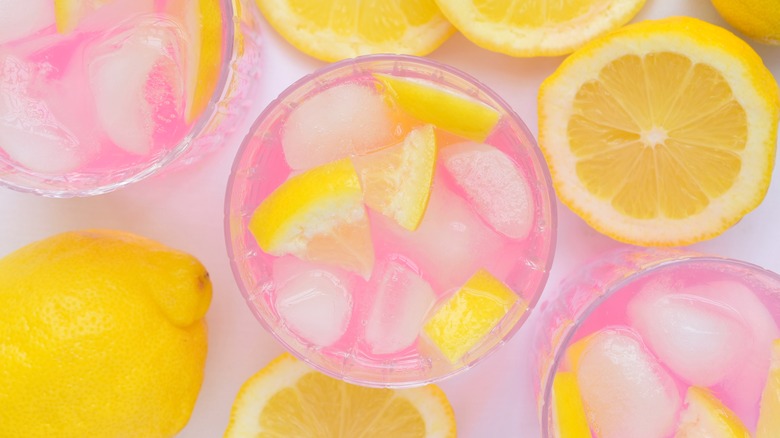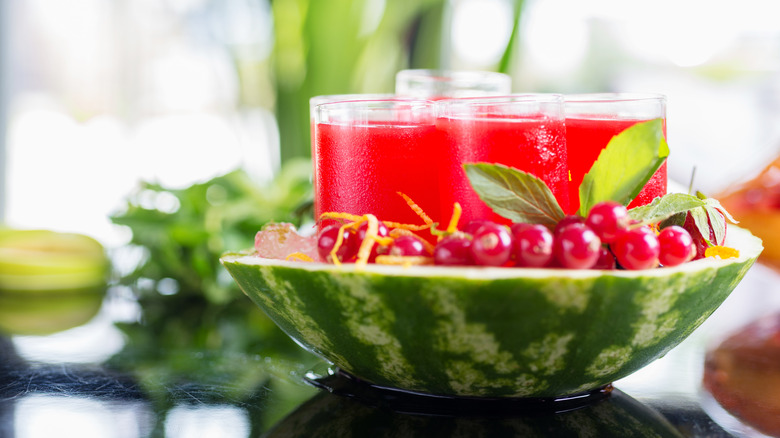What, Exactly, Is The Pink In Pink Lemonade?
When regular lemonade seems too plain, pink lemonade is the chilled summer sipper that strikes the perfect balance between sophisticated and no-fuss. It's interesting to note that much of the pink lemonade experience comes from its color and not its taste, which remains similar to regular lemonade. This is partly explained by a 2019 study published in the journal Experimental Psychology, which found that colors like pink and red are most strongly associated with sweetness ... which also explains Starburst candies. Most bottled pink lemonade is regular lemonade with just some added color from natural ingredients like grapes or plain old food coloring. The first pink lemonade, however, seems to have taken color from a toxic dye used on a pair of circus leggings (more on that in a moment).
While the drink's origin is murkier than its rosy hue, contemporary pink lemonade can be spruced up with various color-inducing ingredients that also ramp up the flavor. A spoonful of syrup, a splash of fruit juice, or even some bitters can all make your lemonade pink. Like regular lemonade, it is a versatile drink that can be served as is or used as a base for alcoholic and non-alcoholic cocktails. Depending on your requirements, you can choose what makes your lemonade blush.
How you turn lemonade pink is up to you
Making pink lemonade starts with making regular lemonade with lemon juice, sugar, and water. With this as your base, you now have virtually limitless options for coloring and flavoring your drink. Sure, there's food coloring, which you can add small amounts of until you get your preferred pink hue. But why miss out on the opportunity to add some interesting notes to your pink lemonade while you're at it?
A splash of cranberry or grapefruit juice to regular lemonade brings complexity by adding a hint of berry tartness and a vibrant red-pink color. If you want to focus on the sweet flavors, an excellent idea for a summer sipper is adding watermelon juice to lemonade to make a delicious pink libation that will surprise its drinkers. The pink lemonade recipe in E.E. Kellogg's Science in the Kitchen from 1892, one of the drink's earliest written descriptions, calls for canned or fresh strawberry, raspberry, cranberry, or currant juices.
For easier prep, turn to red-colored flavored syrups like grenadine or make your own infused simple syrup with your favorite flavors. For a grown-up version of the pink lemonade, take inspiration from pink gin by adding a few dashes of Angostura bitters. Usually, these bitters upgrade cocktails but can also add a herby complexity to pink lemonade, making the drink feel and taste quite sophisticated.
Pink lemonade's murky origins
The drink's alleged origin is shockingly unpalatable but fittingly colorful. Pink lemonade's early popularity stems from it being a crowd-favorite at circuses around the mid-19th century. It started with a disgruntled yet enterprising part-time clown named Pete Conklin who, after a falling out with the Mabie Brothers' Circus over payments, trailed the show selling lemonade to circusgoers. Short on money, Conklin used tartaric acid to give his lemonade its tartness and a single lemon that was more garnish than ingredient.
Once, short on water to make the drink, Conklin had to use the contents of a tub previously employed to wash a circus performer's leggings. Tinged with toxic aniline dye from the bright red leggings, the water gave Conklin's lemonade a pink hue and was promptly marketed as strawberry lemonade! The drink did so well that in an account he gave years later to the Red Bluff News, Conklin said, "My sales were doubled that day, and since then no well-regulated circus is without pink lemonade."
A competing origin story from the New York Times obituary of Henry E. Allott, published in September 1912, states that he was the inventor of pink lemonade. Allott, who also worked in a circus, accidentally dropped red-colored cinnamon candies into lemonade, resulting in a "pink lemonade." Irrespective of which one is true, the results of the latter account seem decidedly less toxic, so we'd recommend you take inspiration from Allott rather than Conklin when making pink lemonade next.


